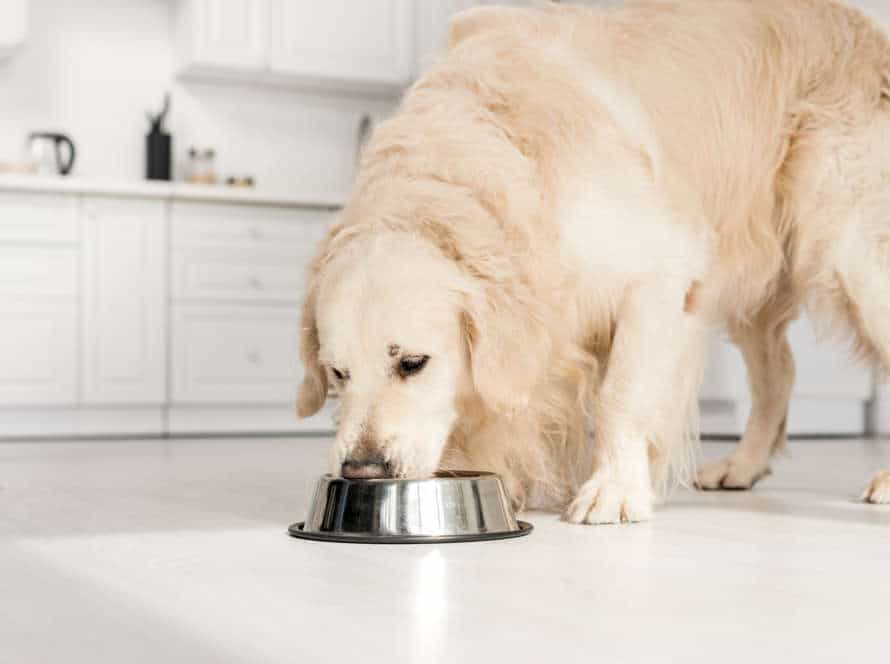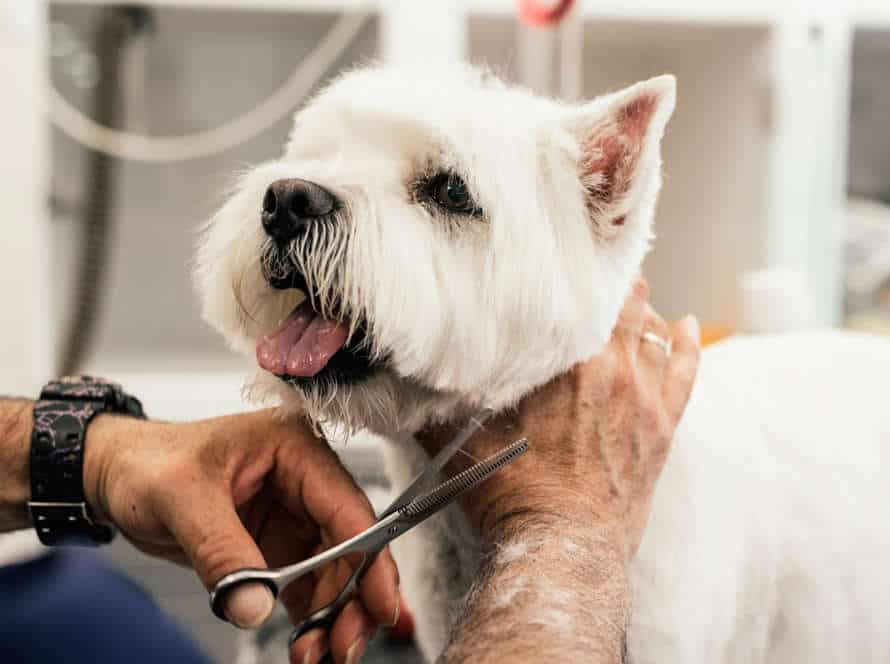Puppy Feeding 101: A Comprehensive Guide
As a new pup parent, it is key to make sure your furry pal is getting the right nourishment. Here is a guide to puppy feeding that covers the basics.
How often?
- Pups up to 3 months need 4 feedings a day.
- 3-6 months old get 3 feedings a day.
- Pups 6 months and older get fed twice a day.
What to feed?
- Choose a top-notch puppy food that follows AAFCO nutrient guidelines.
- Look for whole foods like meat, fish, and veggies.
- Say no to fillers, by-products, and artificial preservatives.
How much?
- Follow the serving size on the food label.
- Adjust it according to activity, weight, and age.
Offer fresh water for your pup to drink.
Types of Puppy Food
When it comes to feeding a puppy, it’s important to know your options. You can choose between wet and dry food. Plus, there’s food specifically made for puppies. This way, you can pick the best option to meet your pup’s needs. Get informed and feed your pup right!
Wet Food
Wet food is a type of pup meal with lots of health benefits. It comes in cans and pouches with extra moisture than dry food. Consider these three types:
- Grain-free wet food – Suitable for puppies with digestion problems or grain allergies.
- High-protein wet food – Perfect for active puppies or those with high energy needs.
- Puppy-specific wet food
– Formulated for puppies during development. Rich in amino acids, vitamins & minerals.
Be sure to read the ingredients list and choose a quality brand. Pro Tip: Mix wet and dry food for variety & texture.
Dry Food
Puppy feeding is vital for being a responsible pet owner. Choices for feeding include dry food. Here are the three kinds of puppy food:
- Dry food: Easy to store, long shelf life and convenient for pet owners. Also helps dental health by removing plaque and tartar. High protein and low carbs are best for your pup’s nutrition.
- Wet food: Moisture content is higher, tastier for picky eaters. Great for puppies with dental issues or jaw pain. But, shorter shelf life and must be refrigerated after opening.
- Semi-moist food: Combination of dry and wet. Moisture content around 25%. Convenient and may have preservatives and sugar. High-quality protein and no artificial colors are best.
Talk to your vet to decide what food is best for your pup’s nutrition.
Semi-moist Food
Semi-moist food is a type of puppy food. It has 25% moisture content. It is popular among pet owners for its convenience, long shelf-life, and tastiness.
Benefits include:
- it is easy to store and handle;
- more flavorful than dry kibble;
- provides good nutrition and hydration.
However, it has more sugar and preservatives than other types of puppy food. It is also more expensive than dry kibble. Plus, it may not be suitable for dogs with certain health conditions.
If you want to feed semi-moist food, choose a high-quality brand. Consult your veterinarian to make sure it is the best option for your pup.
Nutritional Requirements for Puppies
Feeding puppies? It’s crucial to guarantee they get the right nutrients for growing and developing. Puppies quickly develop and require a different nutrition compared to adult dogs. This section will explain the essential dietary requirements for puppies and how to fulfill them.
Protein
Protein is vital for puppies! It helps them grow, develop and stay healthy. Here’s the protein needed at each growth stage:
- Newborns require a high-protein milk diet to help them grow quickly.
- Weaning puppies need a diet of 22-32% protein.
- Puppies 3-6 months old need 18-28%.
- Puppies 6-12 months old require 14-26%.
Remember, not all proteins are the same. Quality proteins from meat, poultry and fish are easier to digest and provide essential amino acids. Pro tip: Always check the protein content and source when buying puppy food.
Fats
Puppies need fats in their diet. They give energy and help absorb vitamins and minerals. Make sure your pup gets enough fats for proper growth. Good sources are chicken, fish and beef. Avoid overfeeding – too much fat leads to weight gain. Avoid processed or fried food. Puppies need diets high in healthy fats and protein, low in carbs. For a healthy weight, and to support development.
Carbohydrates
Carbs are essential for puppies. 30% to 70%, depending on breed, size and activity levels.
Carb sources: whole grains like rice and oats, starchy veg like potatoes and sweet potatoes.
Read the ingredients list carefully. Look for named sources of protein and carbs.
Avoid puppy foods listing “meat” or “animal by-products” as main ingredients. These can be low-quality proteins with fillers like corn and wheat.
Vitamins
Vitamins are super important for puppy growth and development. Here are the essential vitamins and what they do:
- A: Keeps vision, skin, coat healthy and boosts immunity.
- D: Regulates calcium and phosphorus levels for bones and teeth.
- E: Acts as an antioxidant, protects cells and boosts immunity.
- K: Aids with blood clotting and bone metabolism.
- B-Complex: Supports energy metabolism, nerve function, and coat and skin.
- C: Antioxidant helps reduce inflammation and supports immunity.
It is important to talk to your vet to make sure your pup gets the right vitamins.
Minerals
Puppy nutrition needs minerals for them to grow and develop. Here are some minerals important for puppies:
- Calcium – Good for strong bones and teeth to stop bone problems like rickets and deformities.
- Phosphorus – Works with calcium for strong bones and teeth, plus energy and muscle use.
- Iron – Makes healthy blood and oxygen for puppies, and avoids anemia.
- Zinc – Helps immune system, healing wounds, and skin and coat health.
- Copper – Forms connective tissues, and helps the body absorb iron.
It’s important to give puppies minerals. Pro tip: Ask a vet what kind and how much food your puppy should have.
Feeding Schedule for Puppies
Puppy feeding needs a schedule. One which works for both you and your pup! Feeding your pup regularly helps them learn to control their food intake. It also helps create a strong bond between the two of you.
Let’s talk about the ideal feeding schedule for puppies and why it’s so important.
How often should puppies be fed?
Puppies need meals based on age, breed and weight. Here’s a guide:
- Newborns – 2-3 hrs nursing.
- 3-6 wks – 4 times a day, mix of food and milk.
- 6-12 wks – 3-4 times a day, dry food with water.
- 12-24 wks – 2-3 times a day, dry food with water.
- 6-12 months – twice a day, dry or mix food.
Dogs have different needs, so get vet advice for your puppy.
How much food should puppies be given?
Feeding puppies correctly is essential for their health and growth. They require more meals than adult dogs due to their age and activity level. Here’s all you need to know!
The amount of food puppies need depends on breed, size, age and activity. Generally, they should be fed 3-4 meals until they are 6 months old. After six months, you can feed them twice a day, but watch their weight and adjust the food accordingly.
Their diet must include protein, fat, carbs, vitamins and minerals. Choose good quality puppy food or create homemade food to meet their nutritional needs.
Avoid giving puppies table scraps – it can cause stomach problems and health issues. Provide fresh water and check their weight to regulate their feeding schedule and amount.
When to start a feeding schedule?
Starting a feeding schedule for your puppy is essential for their wellbeing and growth. But when is the correct time to create a feeding plan? Generally, pups aged 8-12 weeks need 3-4 meals a day. As they grow, reduce the number of meals slowly. By the time a puppy is 6 months old, they can usually be fed twice daily.
Here are some signs that it is time to start a feeding schedule:
- Your pup is 8 weeks or older
- Your pup has a regular appetite and finishes meals
- Your pup no longer nurses and is ready for solid food
- Your vet has given the okay to start a regular diet.
Establishing a feeding schedule early can help prevent obesity and other health issues in the future. Provide your pup with fresh water and quality food!
Choosing the Right Puppy Food
Choosing puppy food? Consider these factors! Nutritious and balanced, with the right vitamins and minerals for your puppy. Plus, easy to digest – puppies have sensitive tummies. Here’s what to look for:
- Nutritional balance
- Vitamins and minerals
- Easy digestion
Picking the right puppy food is key!
How to read dog food labels
Reading dog food labels is key to picking the right puppy food and making sure your pup gets all the necessary nutrients for healthy growth. You need to know:
- Note the ingredients list: It should be the first thing on the label. Ingredients listed first make up most of the food. Look for real meat first, then whole grains, fruits, and veg.
- Check the guaranteed analysis: This section lists the min amount of protein and fat, and max amount of moisture and fiber. Go for puppy food with at least 22% protein and 8% fat.
- Watch out for artificial preservatives and fillers: Avoid puppy food with artificial colors, flavors, and preservatives, as well as fillers like corn and wheat.
- Observe the AAFCO statement: The Association of American Feed Control Officials (AAFCO) regulates pet food and sets standards for nutrition. Pick a puppy food that meets the AAFCO’s standards for growth and development.
Follow these tips when reading dog food labels. Consult a vet to select the best puppy food for your furry friend.
What to avoid in puppy food
When it comes to selecting puppy food, there are some ingredients and nutrients to dodge. Here are a few:
- Grains: Protein is a must for puppies – some grains in puppy food may not provide the required amino acids for muscle and bone growth.
- Artificial Sweeteners: Steer clear of puppy food containing artificial sweeteners, like xylitol, which can be toxic and lead to liver failure.
- Fillers: Corn, wheat, and soy are fillers found in many puppy foods. These can cause digestive issues and allergies.
- Preservatives: BHA, BHT, and ethoxyquin are preservatives which can be damaging to puppies and linked to cancer and other health problems.
- High Fat Content: Puppies need healthy fats for energy and brain growth, but too much fat can result in obesity and cardiovascular issues.
By avoiding these harmful ingredients, you can select a balanced and nutritious diet for your pup’s growth and overall well-being.
Grain-free vs. Grain-included diets
Choosing a diet for your pup can be tricky. But it’s vital to their health in the long run.
Grain-included diets usually have wheat, corn, and other grains as the main carb source. They are usually cheaper and give young pups lots of energy.
Grain-free diets have no grains. They use other sources of carbs like sweet potatoes or peas. These are perfect for pups with wheat or grain allergies/sensitivities.
Make sure the diet you pick has all the nutrients your pup needs and no fillers or artificial ingredients. Talk to your vet to make sure of this.
Pro tip: To avoid digestive issues, introduce new food gradually over 7-10 days. Mix increasing amounts of the new food with the old each day.
Feeding Tips for Puppies
It’s essential to nourish your puppy. As a responsible pet owner, you must guarantee the best nutrition for your pup. In this article, we’ll cover some crucial puppy-feeding tips and the advantages of following them. From the ideal meal plan to the types of food that are perfect for puppies – there are many things to take into account.
Watch for food allergies and intolerances
When feeding your pup, watch for signs of food allergies and intolerances. Some typical puppy symptoms include vomiting, diarrhea, itchy skin, and ear infections. Here are a few tips:
- Start with a high-quality dog food for their breed, age and size.
- Introduce new food and treats slowly, one at a time.
- Keep track of your pup’s chow and any reactions they show.
- If they have allergies/intolerances, switch to a hypoallergenic or limited-ingredient diet.
- Ask your vet for advice.
Pro tip: Read labels and avoid wheat, soy, corn, and dairy products.
Introduce new foods slowly
Feeding pups? Make sure to introduce new food slowly. Here are some tips:
- Start small – mix old food with new.
- Increase the amount of new food over a week or two.
- Keep an eye on stools – no diarrhea, vomiting, or constipation.
- Set a regular feeding schedule. Don’t free-feed.
- Provide fresh water always. No snacks or human food – can upset their stomach or cause weight gain.
- Consult a vet – ensure pup gets all the required nutrients based on breed, age, weight, and health.
Provide clean water at all times
For your puppy, clean water is a must! Just like us humans, it’s needed for their survival and growth.
Here’s how you can provide clean water to your pup:
- Give them access to fresh water all the time, especially when it’s hot outside or after exercise.
- Change the water in their bowl daily to prevent contamination.
- Clean the water bowl with soap and water, then rinse to get rid of any soap residue.
- Try a water fountain for their water source – it keeps the water circulating and filtered.
Pro Tip: To make sure they’re getting enough water, measure the amount of water in their bowl each day and check what’s left. This helps you monitor their health and hydration.
Conclusion: Happy and Healthy Puppies
To sum up, it’s key to give your pups the right food and the right amount. You can opt for commercial puppy food or home-cooked meals. Just make sure they get their nutritional requirements and that it is suitable for their age and size. Follow the tips in our guide – feed them at certain times and stay away from certain foods – to ensure they become strong and healthy. And, most vitally, keep an eye on their body language and actions. If you spot any odd symptoms or changes in their eating, consult a vet.
Frequently Asked Questions
Frequently Asked Questions
Q: When should I start feeding my puppy solid food?
A: Puppies can start eating solid food around 4-6 weeks of age. It’s important to introduce solid food gradually and monitor their reaction to it.
Q: How often should I feed my puppy?
A: Puppies need to be fed more frequently than adult dogs. It’s recommended to feed them 3-4 times a day until they reach 5-6 months of age.
Q: What type of food should I feed my puppy?
A: High-quality puppy food that contains protein and nutrients is recommended. It’s important to read the labels and choose a food that meets your puppy’s needs.
Q: Can I share my human food with my puppy?
A: It’s not recommended to share human food with your puppy as it can cause digestive issues and lead to weight gain. Stick to feeding your puppy a balanced diet of puppy food.
Q: How much should I feed my puppy?
A: The amount of food your puppy needs depends on their age, weight, and breed. You can use the guidelines on the puppy food label as a starting point and adjust accordingly based on their individual needs.
Q: When should I switch my puppy to adult dog food?
A: Puppies usually need to be on a puppy food diet until they reach 12-18 months old. Consult with your veterinarian on the best time to switch to adult dog food.







